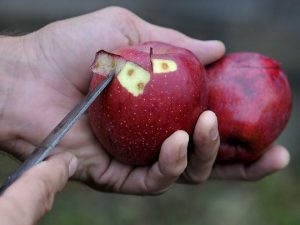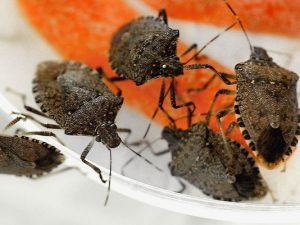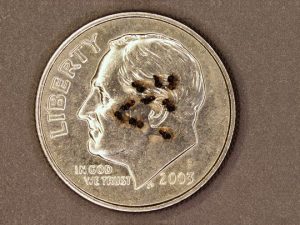
HIGHLAND – Scientists are getting ready to escalate an unseen war.
The life-and-death battle is to rage between two invasive insects, one a residential nuisance and agricultural nightmare, the other a tiny squatter smaller than a pinhead.
If all goes according to plan, homeowners and farmers in as many as eight states including New York will see fewer brown marmorated stink bugs infesting their houses and sucking the life from their fruits and vegetables.
The bug “is one of the most severe invasive agricultural pests because it feeds on so many different kinds of important crops,” said Kim Hoelmer, an entomologist with the U.S. Department of Agriculture. “It is capable of doing a lot of damage.”
 A stink bug feeds by inserting its mouth parts into plants and removing juices like a milkshake. Mid-Atlantic apple growers blamed it for an 18 percent crop loss in 2010 costing $37 million.
A stink bug feeds by inserting its mouth parts into plants and removing juices like a milkshake. Mid-Atlantic apple growers blamed it for an 18 percent crop loss in 2010 costing $37 million.
In New York, they have been reported most frequently in the mid-Hudson Valley, with Ulster, Dutchess and Orange counties having the highest number of reports, according to an invasive species mapping system developed at the University of Georgia.
Scientists have known for some time that a species of tiny wasp, Trissolcus (pronounced Treh-SOL-kus) Japonicus (better known as the Samurai wasp), likes to lay its eggs inside the eggs of stink bugs.
The wasps do not sting humans. But for stink bugs, the process gives new meaning to the term “bad egg” and has frequently been equated with the birth scene in the 1979 film “Alien.”

In the United States, the parasitic infestations have been too infrequent to slow the stink bug’s spread. This year, scientists will try to change that.
For the first time, they will rear legions of Samurai wasps in the laboratory, infest stink bug eggs and then make like Johnny Appleseed with the compromised hosts.
Out will come newborn wasps, intensifying a circle of life that spells doom for the crunchy insects named for the odor they emit at the business end of a shoe.
The rearing and release of wasps has been greenlighted in Oregon. It is expected to be approved in New York, according to Peter Jentsch, director of the Hudson Valley Research Laboratory in Highland.
The process is being evaluated in six other states where the wasps have been found in the wild — Washington, West Virginia, Virginia, Delaware, Maryland and New Jersey. Like stink bugs and many other invasive pests, the wasps were unintentionally introduced to North America from Asia.
The wasp discoveries are important because they can speed permitting processes within states. Federal approvals are needed if wasps are to be moved across state lines and introduced in a state in which they have not been identified
In New York, the first discovery came last summer in the Town of Marlborough. Jentsch and his co-workers placed stink bug eggs on the leaves of jalapeno pepper plants at Hepworth Farms, a family-owned organic farm in Milton.
“They love jalapeno peppers, probably more than any other plant,” Jentsch said.
The scientists wanted to know if anything in the area was causing grief for the eggs.
“What you find is insects that chew on them, insects that steal them like ants, and then insects that probe them, such as other stink bugs,” he said.
Lo and behold, they found eggs parasitized by the wasps.

“We got really lucky,” Jentsch said. “There are a lot of other researchers who have put eggs all over creation for the last five years and captured nothing.”
Now comes the hard part. It’s one thing to come up with a plan to augment the wasp populations. It’s another thing to make it happen.
“The ability to disperse the wasps is dependent on whether or not they can rear enough of them in a laboratory,” said Jim Walgenbach, a professor of entomology at North Carolina State University.
Scientists at the Highland lab have been rearing increasing numbers of stink bugs in order to generate the eggs needed to make more wasps.
“We put out over 6,000 eggs last year,” Jentsch said. “We need to quadruple that number. We are going to have stink bugs coming out of the woodwork.”
Scientists also need help from the public. A website has been created that allows anyone to report sightings of brown marmorated stink bugs.
The scientists want to update their understanding of where the bugs are causing the greatest nuisance and most damage.
Jentsch said he hopes to be begin distributing the bad eggs this summer.

